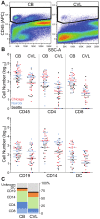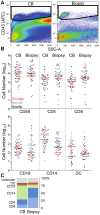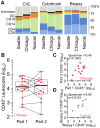Optimizing viable leukocyte sampling from the female genital tract for clinical trials: an international multi-site study
- PMID: 24454917
- PMCID: PMC3893217
- DOI: 10.1371/journal.pone.0085675
Optimizing viable leukocyte sampling from the female genital tract for clinical trials: an international multi-site study
Abstract
Background: Functional analysis of mononuclear leukocytes in the female genital mucosa is essential for understanding the immunologic effects of HIV vaccines and microbicides at the site of HIV exposure. However, the best female genital tract sampling technique is unclear.
Methods and findings: We enrolled women from four sites in Africa and the US to compare three genital leukocyte sampling methods: cervicovaginal lavages (CVL), endocervical cytobrushes, and ectocervical biopsies. Absolute yields of mononuclear leukocyte subpopulations were determined by flow cytometric bead-based cell counting. Of the non-invasive sampling types, two combined sequential cytobrushes yielded significantly more viable mononuclear leukocytes than a CVL (p<0.0001). In a subsequent comparison, two cytobrushes yielded as many leukocytes (∼ 10,000) as one biopsy, with macrophages/monocytes being more prominent in cytobrushes and T lymphocytes in biopsies. Sample yields were consistent between sites. In a subgroup analysis, we observed significant reproducibility between replicate same-day biopsies (r = 0.89, p = 0.0123). Visible red blood cells in cytobrushes increased leukocyte yields more than three-fold (p = 0.0078), but did not change their subpopulation profile, indicating that these leukocytes were still largely derived from the mucosa and not peripheral blood. We also confirmed that many CD4(+) T cells in the female genital tract express the α4β7 integrin, an HIV envelope-binding mucosal homing receptor.
Conclusions: CVL sampling recovered the lowest number of viable mononuclear leukocytes. Two cervical cytobrushes yielded comparable total numbers of viable leukocytes to one biopsy, but cytobrushes and biopsies were biased toward macrophages and T lymphocytes, respectively. Our study also established the feasibility of obtaining consistent flow cytometric analyses of isolated genital cells from four study sites in the US and Africa. These data represent an important step towards implementing mucosal cell sampling in international clinical trials of HIV prevention.
Conflict of interest statement
Figures




Similar articles
-
Stability and transport of cervical cytobrushes for isolation of mononuclear cells from the female genital tract.J Immunol Methods. 2011 Mar 31;367(1-2):47-55. doi: 10.1016/j.jim.2011.01.013. Epub 2011 Feb 12. J Immunol Methods. 2011. PMID: 21324321 Free PMC article.
-
Characteristics of HIV target CD4 T cells collected using different sampling methods from the genital tract of HIV seronegative women.PLoS One. 2017 Jun 1;12(6):e0178193. doi: 10.1371/journal.pone.0178193. eCollection 2017. PLoS One. 2017. PMID: 28570576 Free PMC article.
-
Performance of swabs, lavage, and diluents to quantify biomarkers of female genital tract soluble mucosal mediators.PLoS One. 2011;6(8):e23136. doi: 10.1371/journal.pone.0023136. Epub 2011 Aug 12. PLoS One. 2011. PMID: 21858008 Free PMC article.
-
Optimization of processing female genital tissue samples for lymphocyte analysis by flow cytometry.Am J Reprod Immunol. 2020 May;83(5):e13227. doi: 10.1111/aji.13227. Epub 2020 Feb 13. Am J Reprod Immunol. 2020. PMID: 31991032 Free PMC article.
-
Comparison of polyclonal expansion methods to improve the recovery of cervical cytobrush-derived T cells from the female genital tract of HIV-infected women.J Immunol Methods. 2010 Mar 31;354(1-2):68-79. doi: 10.1016/j.jim.2010.02.002. Epub 2010 Feb 8. J Immunol Methods. 2010. PMID: 20149794 Free PMC article.
Cited by
-
Challenges in mucosal HIV vaccine development: lessons from non-human primate models.Viruses. 2014 Aug 15;6(8):3129-58. doi: 10.3390/v6083129. Viruses. 2014. PMID: 25196380 Free PMC article. Review.
-
Determination of the Membrane Permeability to Water of Human Vaginal Mucosal Immune Cells at Subzero Temperatures Using Differential Scanning Calorimetry.Biopreserv Biobank. 2016 Aug;14(4):307-13. doi: 10.1089/bio.2015.0079. Epub 2016 Mar 15. Biopreserv Biobank. 2016. PMID: 26977578 Free PMC article.
-
Distinct mucosal and systemic immunological characteristics in transgender women potentially relating to HIV acquisition.JCI Insight. 2023 Aug 22;8(16):e169272. doi: 10.1172/jci.insight.169272. JCI Insight. 2023. PMID: 37432754 Free PMC article.
-
OMIP-070: NKp46-Based 27-Color Phenotyping to Define Natural Killer Cells Isolated From Human Tumor Tissues.Cytometry A. 2020 Oct;97(10):1052-1056. doi: 10.1002/cyto.a.24230. Epub 2020 Oct 8. Cytometry A. 2020. PMID: 32978859 Free PMC article.
-
Diminished HIV Infection of Target CD4+ T Cells in a Toll-Like Receptor 4 Stimulated in vitro Model.Front Immunol. 2019 Jul 23;10:1705. doi: 10.3389/fimmu.2019.01705. eCollection 2019. Front Immunol. 2019. PMID: 31396221 Free PMC article.
References
Publication types
MeSH terms
Grants and funding
LinkOut - more resources
Full Text Sources
Other Literature Sources
Medical
Research Materials

